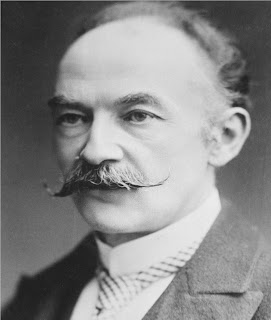A Study of Author Thomas Hardy
Blogger: http://desaikaushal1315.blogspot.com
Slideshare: http://www.slideshare.net/kaushal111
Kaushal Desai
kaushaldesai123@gmail.com
A Study of Author Thomas Hardy
Introduction:
First
of all, literature makes variety kind of concept to understand and to come out
with new idea that one must be learning of and make impact on the society. Here
is genius writer Thomas Hardy, who expanded the Victorian era and showed the
realistic picture of it. To study the writer one has to study all the elements
which writer is writing in his work. He uses make kind of concepts like pessimism,
an overwhelming feeling of irony, naturalism, feminism. These all makes
impact on the writing part and other things like Thomas Hardy is showing is
about fate and chance, dignity of the person. Thomas Hardy portrays woman
characters in a contrasting way. One cannot identify that Hardy is with the
women character or he is showing the harshness and punishing women on the
targeting on Victorian period. Thomas Hardy’s masterpieces of novel is Under
the Greenwood Tree 1872, A Pair of Blue Eyes 1873, Far from the
Madding Crowd 1874, The Return of the Native 1878, The Mayor of
Casterbridge 1886, Tess of the D’Urbervilles 1891, Jude the
Obscure 1896. In 1898 Hardy published his first volume of poetry,
Wessex Poems, a
collection of poems written over 30 years. Hardy claimed poetry as his first
love, and after a great amount of negative criticism erupted from the
publication of his novel Jude The Obscure, Hardy
decided to give up writing novels permanently and to focus his literary efforts
on writing poetry. All the facts show that Thomas Hardy gives major elements in
his works and shows realness of the time.
Thomas
Hardy’s technique of writing:
He is
writing in such a way that reader finds lots of description and information
about particular work. His using of memories, future techniques like “what will
be?” that excitement gives his charm of writing. He is using situations in
right place right time that can make effort to observe. He writes in specific
location that also shows his novel’s location and that is Wessex area. Thomas
Hardy’s harmonious plot makes reader more comfortable with it and it gives
spark to read Thomas Hardy.
Major
themes of his writing:
Thomas
Hardy is using various kinds of themes like man’s importance against greater forces
of nature, of society, of his impulses and targeting on the desire of love. One
can also find out themes like Pessimism, sadness, waste and frustration,
naturalism, use of irony etc. like many of these themes we find in Hardy’s Far
From The Medding Crowd and Tess of the
D’Urbervilles.
“Pessimism
in Thomas Hardy’s Novel”
In
the early 1860s, after the appearance Darwin's Origin of Species (1859), Thomas
Hardy bravely challenged many of the sexual and religious conventions of the
Victorian age, but he soon adopted the mechanical-determinist view of
universe's cruelty, reflected in the inevitably tragic and self-destructive
fates of his characters. In his poems Hardy depicted rural life without sentimentality?
his mood was often stoically hopeless. Fate plays a major role in many
of Hardy's novels; both Tess of the D'Urbervilles and The Mayor of Casterbridge
contain various instances where its effects are readily apparent. Moreover,
Hardy's novels reflect a pessimistic view where fate, or chance, is responsible
for a character's ruin. The center of his novels was the rather isolated and
history-freighted countryside around Dorchester. Hardy's writing novels of
“Wessex,” the historical, Anglo-Saxon name he gave in fiction to his native
Dorset, from this time until 1895. Thomas hardy gives element of pessimistic
approach that how Bathsheba Everdene meets three shooters and how her thoughts
get effected with all three person and herself as well. But one remarkable
comment over pessimist approach that; R.A. Scott James observes: “Hardy
did not set out to give us a pessimistic philosophy.. Hardy is pessimistic
about the governance of the Universe, but not about human beings.”
Fear
and Fascination in Thomas Hardy’s novels:
It
was the end of the Victorian era, and Hardy was torn between his desire to
portray women as capable and intelligent, while preserving his own essentialist
ideas. Through his novels, Hardy offered his women a voice reflecting the
anxiety and ambiguity of their changing role in society. One of his most
successful heroines, Bathsheba Everdene, best articulates women’s difficulty in
expressing themselves. In her effort to dissuade Farmer Boldwood from his
marriage proposition as a business transaction, Bathsheba exclaims, “It is
difficult for a woman to define her feelings in a language which is chiefly
made by men to express theirs”. This point suggests tragic outcome of most
of his fictional female characters, harshly punishing woman for their open
defiance of Victorian society. Hardy throws the picture of realness with harsh
reality premarital sex, rape, illegitimate children, adultery, and divorce.
Gender
in Thomas Hardy’s Far From the Madding Crowd:
Thomas
Hardy represents female gender which women were seen as ‘the weaker sex’.
Because these opinions were considered the norm, oftentimes they shone through
in an author’s writing. The question comes that how Hardy really felt about
woman?. If we look at Bathsheba’s character, does Hardy sympathize with her? Or
is he using her to show what a Victorian woman should not be? The young
Bathsheba Everdene exhibits unusual qualities for a female character in a
Victorian novel written by a male author. She is, more or less, the protagonist
of the story. Emily Constable says, “The salvation of a discouraged,
ruined, or crippled man by the female heroine appears in several Victorian
novels written by women.”
Conclusion:
These
all the aspects suggest his mind map of writing and giving the realistic
picture of Victorian time. And he has done that with greater effect. It is also
rightly observed that many people view Thomas Hardy to be a feminist writer
because of his strong female characters. Bathsheba Everdene, the female
protagonist in Far From the Madding Crowd, is no exception; however, there are
some instances where the reader may question how Hardy considers women and
their privileges. Victorian England was not exactly rational when it came to
the female gender. It is fair to say that these opinions most likely influenced
Hardy’s writing, along with many other writers of his time. Hardy could have
written Bathsheba as a rebellion to the Victorian opinion of the woman, but he
also could have written her to show how deceiving and destructive a woman could
have been at that time.
Reference Links:
https://www.goodreads.com/book/show/31463.Far_from_the_Madding_Crowd
https://archive.org/details/thomashardyacrit010428mbp
https://www.britannica.com/biography/Thomas-Hardy
Reference Links:
https://www.goodreads.com/book/show/31463.Far_from_the_Madding_Crowd
https://archive.org/details/thomashardyacrit010428mbp
https://www.britannica.com/biography/Thomas-Hardy


Comments
Post a Comment